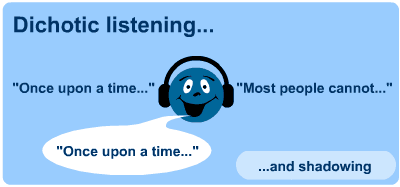Information processing and attention
3.Information processing and attention
Focused or selective attention refers to the mechanism by which certain information is registered while others are rejected.Capacity or divided attention refers to the upper limit of the amount of processing that can be performed on incoming information at any one time.
Many studies of attention have used auditory tasks.
- Dichotic listening refers to feeding one message into the left ear and a different message simultaneously into the right ear. Participants have to repeat one of the messages aloud. This process is called Shadowing (first used by Cherry). This is a method to study selective attention. Divided attention can be tested using a dual-task technique whereby the individual is asked to attend and respond to both or all incoming messages.
- Cocktail party effect: It is a concept related to selective attention. It is a term used in early attention research ‘to describe the ability of people to be able to switch their attention rapidly to a nonprocessed message’. The cocktail party effect shows that certain types of stimuli can elicit switching between messages e.g. the physical location of the speaker, the pitch of the voice or the use of familiar stimuli such as the listener’s name. (Lunch-queue effect)
- Broadbent’s early selection filter theory:
- Our ability to process information is capacity limited.
- A temporary buffer system receives all information and passes it to a selective filter.
- The selection is based on physical characteristics of the information – one source is selected and others are rejected.
- Processing two different pieces of information will take longer and will be less efficient as switching takes a substantial period of time.
- Triesman’s attenuation theory:
- Treisman (1964) proposed that physical characteristics and semantic relevance (meaning) are used to select one message for full processing while other messages are given partial processing.
- Deutsch-Norman late selection filter model:
- This model rejects Broadbent and suggests that filtering occurs only later, after all inputs are analysed at a higher level. This is also called the pertinence model.
- Pigeon-holing:
- Later Broadbent revised the early selection filter theory and stated that apart from filtering, pigeon-holing can also take place.
- Pigeonholing is similar to filtering but selection is not based on physical characters; it is based on categorization.
- E.g. if one is asked to attend to the names of animal (a category) from many stimuli, this will take place irrespective of physical characters such as volume, pitch etc.
- Automaticity
- Automatic processing:
- Does not require conscious attention
- Unaffected by capacity limits
- Difficult to modify
- E.g. driving a car or listening to the radio
- Controlled processing:
- Requires attention
- Heavy demands
- Slow and capacity limited
- E.g. reading this notes!
- Automatic processing:
- Closed loop control: when we first learn a task it is under conscious attention system. When we become skilled at it, open loop control takes over. Open loop is controlled by automatic motor processes. It is fast and allows conscious attention to be diverted to other activities.
- Stroop test and letter cancellation tasks can test selective attention.

| Focused attention | The ability to perceive individual items of information (respond discretely to the specific modality of stimuli). |
|---|---|
| Sustained attention | The ability to maintain a consistent behavioral response during continuous and repetitive activity. Also called as vigilance or concentration |
| Selective attention | The ability to avoid distractions from internal or external cues and maintain a behavioural or cognitive set in the face of competing stimuli. |
| Alternating attention | The ability of mental flexibility that allows individuals to shift their focus of attention and move between tasks having different cognitive requirements. |
| Divided attention | This is the highest level of attention and it refers to the ability to respond simultaneously to multiple tasks or multiple task demands. It is much more difficult to achieve within same modality (e.g. visual) as it is between different modalities (visual and auditory) |
A hierarchical model of attention: Sohlberg and Mateer proposed a clinically useful model of evaluating attention in a hierarchical fashion based on the sequential recovery of attentional ability in patients with brain damage. Five different kinds of activities of growing difficulty are described in the model connecting with the activities that patients could do as they recover gradually. This model has been clinically useful in terms of rehabilitation of brain-damaged patients.
Studies of attention in schizophrenia suggest that there is an underlying attentional abnormality for those with a genetic predisposition for psychosis. The overall reaction time is much slower in patients with schizophrenia and their relatives; sustained attention, distraction, verbal memory and controlled processing are also affected.




Comments
Post a Comment